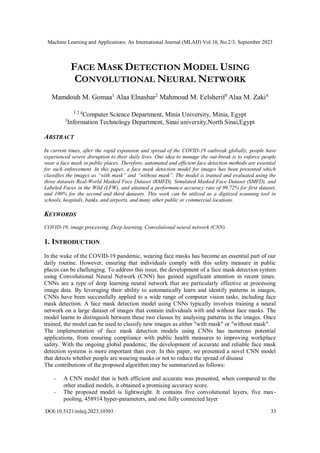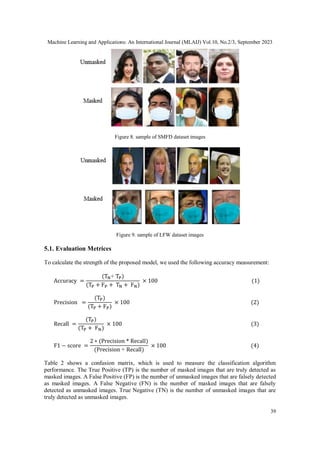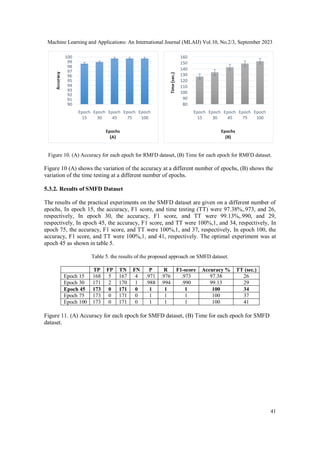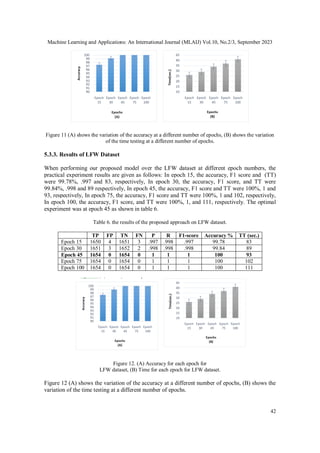This paper presents a convolutional neural network (CNN) model for face mask detection, addressing the enforcement of mask-wearing during the COVID-19 pandemic. The model demonstrated high accuracy rates of 99.72% on the real-world masked face dataset and 100% on simulated and labeled datasets, making it suitable for automated use in various public places. The study discusses the architecture and performance of the CNN, trained on multiple datasets, and compares results with existing methods in face mask detection.

![Machine Learning and Applications: An International Journal (MLAIJ) Vol.10, No.2/3, September 2023
34
- Three benchmark datasets were used in the experiments. These datasets are RMFD[11],
(SMFD) [12], (LFW) [13]. It is allowed us to present accurate experiments.
The remainder of this paper is structured as follows: The related works are presented in section 2.
In section 3, we will discuss a basic overview of CNN. While section 4 goes into great detail
about the proposed method, section 5 presents the experimental results obtained from the
proposed method and a comparison with other methods. Finally, section 6 brings the conclusion
of the paper.
2. RELATED WORK
Most of the published research focuses on building the face and recognizing the identity of the
face when wearing face masks. In this research, we focus on identifying whether people wear the
face mask or not, to help reduce the transmission and spread of COVID 19, as scientists and
researchers have proven that wearing face masks helps reduce the spread of Covid 19 infection.
Bosheng Qin et al. [1] developed a facemask-wearing condition identification method that
categorized facemask-wearing conditions into three categories: no facemask-wearing (NFW),
incorrect facemask-wearing (IFW), and correct facemask-wearing (CFW). In face detection
phase, this method achieved an accuracy of 98.70%. In a paper by Zekun Wang et al. [2], an in-
browser serverless edge computing-based mask detection solution called Efficient Web-Based AI
Mask Recognition (WearMask) was developed. The author employed (1) deep learning models
(YOLO), (2) a high-performance neural network inference computing framework (NCNN), and
(3) a stack-based virtual machine (WebAssembly), which achieved an accuracy of 89%. Sabbir et
al. [3] used Principal Component Analysis (PCA) on masked and unmasked facial recognition to
recognize the person. They discovered that, wearing masks significantly reduces the accuracy of
facial resonance using PCA. When the detected face is veiled, the identification accuracy declines
to less than 70%. Jeong-Seon Park et al. [4] also made use of PCA. The authors suggested a
method for eliminating glasses from a frontal-face picture of a human. The deleted portion was
rebuilt using iterative error compensation and PCA reconstruction. In Guiling Wu [5], the
attention mechanism neural network is used to reduce the information loss in the subsampling
process and improve the face recognition rate. After separating the masked face image by the
local constrained dictionary learning method, the dilated convolution is used to reduce the
resolution reduction. There were two datasets used: (1) RMFRD dataset, which had an accuracy
of 98.39% in image with mask and 95.31% in image without mask, and (2) SMFRD, which had
an accuracy of 98.10% in image without mask and 95.22% in image with mask. Chong Li et al.
[6] used the YOLOv3. This algorithm was applied to two datasets, CelebA and WIDER FACE,
for training and FDDB for testing, which achieved an accuracy of 93.9%. Nizam Ud Din et al. [7]
used a GAN-based network with two discriminators, one to assist in learning the overall structure
of the face and the other to focus learning on the deep missing region. The suggested model
produces a full-face picture that seems natural and realistic. The CelebA dataset is used for
training, and real-world images collected from the Internet are used for testing. Muhammad et al.
[8] introduced MRGAN, an interactive technique. The approach relies on obtaining the
microphone area from the user and rebuilding it using the Generative Adversarial Network. Deep
learning real-time facial emotion categorization and identification was employed by Shaik et al.
[9]. They classified seven facial expressions using VGG-16. The suggested model was trained
using the KDEF dataset and attained an accuracy of 88%. A. Nieto-Rodríguez et al. [10] The
authors demonstrated a method for detecting the presence or absence of an operating room
mandatory medical mask. The ultimate goal is to reduce the number of false positive face
detections while avoiding missing mask detections in order to activate alerts exclusively for
medical personnel who do not wear surgical masks. The suggested approach achieved 95%
accuracy. The following table summarize the previous models for face detection.](https://image.slidesharecdn.com/10323mlaij03-231012122841-e263b91f/85/FACE-MASK-DETECTION-MODEL-USING-CONVOLUTIONAL-NEURAL-NETWORK-2-320.jpg)
![Machine Learning and Applications: An International Journal (MLAIJ) Vol.10, No.2/3, September 2023
35
3. CONVOLUTIONAL NEURAL NETWORK
CNN is a multilayer neural network structure simulating the operation mechanism of a biological
vision system. This is due to its great ability to extraction important features from image. CNN
has been used for image classification and image recognition problems. because it helped us to
solve many of the problems we faced it in the neural network, as it provided us with local
connectivity, parameter sharing (feature map) and pooling subsampling hidden unit.
Figure 1. Structure of a convolutional neural network (CNN)[16].
As CNN includes many layers, which are convolutional layer, max pooling layer, flattening layer
and full connection layer.
1) Convolutional layer: it is the activation function and a non-linear function and it has
several types, the most commonly used of them
Relu (rectified linear unit), its importance to does not do all neural at the
same time, which contributes to reducing the number of accounts
performed.
Sigmoid which used in the output layer.
Figure 2. The Convolution Layer operation[17].
2) Max pooling layer: reduce the dimensionality of each feature map and retain the most
important information of an image, spatial pooling can be different types max, average,
sum.](https://image.slidesharecdn.com/10323mlaij03-231012122841-e263b91f/85/FACE-MASK-DETECTION-MODEL-USING-CONVOLUTIONAL-NEURAL-NETWORK-3-320.jpg)
![Machine Learning and Applications: An International Journal (MLAIJ) Vol.10, No.2/3, September 2023
36
Figure 3.max pooling operation with 2 × 2 filter[18].
3) Flattening layer: we need it to convert the output of the convolutional part of CNN into
one dimension feature vector to be used by Artificial neural network (ANN) part.
Figure 4.Flattening of Pooled Feature Maps[19].
4) Fully connected: in this phase each neuron is connected to every neuron in the previous
layer, allowing the layer to learn complex non-linear relationships between the input
features and the output classes. The input to each neuron in the fully connected layer is a
weighted sum of the output from the previous layer, which is then passed through an
activation function to introduce non-linearity.
Figure 5. Convolution Neural Network Layers [20].](https://image.slidesharecdn.com/10323mlaij03-231012122841-e263b91f/85/FACE-MASK-DETECTION-MODEL-USING-CONVOLUTIONAL-NEURAL-NETWORK-4-320.jpg)
![Machine Learning and Applications: An International Journal (MLAIJ) Vol.10, No.2/3, September 2023
37
4. PROPOSED METHOD
In this research, we have introduced an accurate face mask detection model based on the CNN
model as shown in Figure 1. The CNN approach deals with the image as a whole, while the
traditional approach deals with images as a block-based algorithm. Our model consists of three
stages:
1) preprocessing stage: image resized without any cropping any parts of the image for
preparing it for the next stage.
2) feature extraction stage: consists of five convolution layers each of them followed by a
max-pooling layer.
3) classification stage: after extracting all features, a fully connection layer connects all
features with the dense layer, then the classifier categorizes the image as (masked or
unmasked).
The convolutional layer used it for mining features from the input image, where each convolution
layer develops its own collection of feature maps using its own set of filters (i.e., ReLU). The
generated feature maps of the first convolution layer are used as input for the next max-pooling
layer to generate resized pooled feature maps, and the output is considered as input for the next
convolution layer. This process is repeated until the last convolution layer and max-pooling layer
block. The final pooled feature maps that have been related to the final max-pooling are included
as input into the global average pooling. Finally, the outputs generated from global average
pooling are vectorized in a fully connected way with a dense layer. The dense layer retrieves
features into two groups (masked or unmasked).
Figure 6. the proposed Convolutional Neural Network model.
5. RESULTS AND DISCUSSION
5.1. Datasets Characteristics
This model was tested on two sets of original data. The first dataset is the Real-World Masked
Face Dataset (RMFD) [11], which is considered one of the largest datasets. This dataset consists
of 95,000 faces, including 5,000 faces with a mask and 90,000 faces without a mask. Figure 7](https://image.slidesharecdn.com/10323mlaij03-231012122841-e263b91f/85/FACE-MASK-DETECTION-MODEL-USING-CONVOLUTIONAL-NEURAL-NETWORK-5-320.jpg)
![Machine Learning and Applications: An International Journal (MLAIJ) Vol.10, No.2/3, September 2023
38
shows samples of faces with and without masks. In this research, we conducted our experiments
on 5,000 images of faces with a mask and 5,000 images of faces without a mask, for a total of
10,000 images. The second dataset is a Simulated Masked Face Dataset (SMFD) [12]. This set
consists of 1,376 images, including 690images of masked faces and 686 images of faces without
a mask. Figure 8 shows samples of faces with a mask and faces without a mask. The third dataset
is Labeled Faces in the Wild (LFW) [13]. The dataset contains more than 13,000 images of faces
collected from the web. Face masks have been placed on some of the dataset images. Figure 9
shows samples of faces with a mask and faces without a mask. All details of division of datasets
shown in table 1, the images in the three dataset divided into three group (training group, test
group, and verification group).
Table 1. the characteristics of RMFD, SMFD, LFW datasets
Figure 7. sample of RMFD dataset images
Dataset Composition
No. of training
Images
No. of validation
Images
No. of testing
Images
The
input
shape
RMFD
[11]
10000 images 5000 images 2500 images 2500 images
224 ×
244
pixels
Masked
5000
unmasked
5000
masked
2500
unmasked
2500
masked
1250
unmasked
1250
masked
1250
unmasked
1250
SMFD
[12]
1376 images 688 images 344 images 344 images
224 ×
244
pixels
Masked
690
unmasked
686
masked
344
unmasked
344
masked
173
unmasked
171
masked
173
unmasked
171
LFW
[13]
13233 images 6617 images 3308 images 3308 images
224 ×
244
pixels
Masked
6616
unmasked
6617
masked
3308
unmasked
3309
masked
1654
unmasked
1654
masked
1654
unmasked
1654](https://image.slidesharecdn.com/10323mlaij03-231012122841-e263b91f/85/FACE-MASK-DETECTION-MODEL-USING-CONVOLUTIONAL-NEURAL-NETWORK-6-320.jpg)

![Machine Learning and Applications: An International Journal (MLAIJ) Vol.10, No.2/3, September 2023
40
Table 2. confusion matrix
Actual Value
Positive Negative
Predicted Value
Positive
TP
(True Positive)
FP
(False Positive)
Negative
FN
(False Negative)
TN
(True Negative)
5.2. Output and Results
Our method was tested over three datasets: RMFD, SMFD, and LFW. The results are compared
to techniques that have recently been published (M. Dwisnanto et al. [14], Loey et al. [15]). Table
3 displays a confusion matrix for three datasets, where sign (+) denotes masked images and sign
(-) denotes unmasked images.
Table 3. The Confusion Matrix of the Proposed Approach with SMFD, RMFD, and LFW Dataset
Dataset Classes + - Total
RMFD
+ 1245 5 1250
- 2 1248 1250
Total 1247 1253 2500
SMFD
+ 173 0 173
- 0 171 171
Total 173 171 344
LFW
+ 1654 0 1654
- 0 1654 1654
Total 1654 1654 3308
5.3.1. Results of RMFD dataset
Experiments were performed on RMFD dataset and the results were as follows: In epoch 15, the
accuracy, F1 score, and time testing (TT) were 98.64%,.985, and 127, respectively, In epoch 30,
the accuracy, F1 score, and TT were 98.96%,.988, and 134, respectively, In epoch 45, the
accuracy, F1 score, and TT were 99.72%,.996, and 143, respectively, In epoch 75, the accuracy,
F1 score, and TT were 99.72%,.996, and 149, respectively, In epoch 100, the accuracy, F1 score,
and TT were 99.72%,.996,153 and , respectively. The optimal experiment was at epoch 45 as
shown in table 4.
Table 4. the results of the proposed approach on RMFD dataset.
TP FP TN FN P R F1-score Accuracy% TT (sec.)
Epoch 15 1229 21 1237 13 .983 .989 .985 98.64 127
Epoch 30 1233 17 1241 9 .986 .992 .988 98.96 134
Epoch 45 1245 5 1248 2 .996 .998 .996 99.72 143
Epoch 75 1245 5 1248 2 .996 .998 .996 99.72 149
Epoch 100 1245 5 1248 2 .996 .998 .996 99.72 153](https://image.slidesharecdn.com/10323mlaij03-231012122841-e263b91f/85/FACE-MASK-DETECTION-MODEL-USING-CONVOLUTIONAL-NEURAL-NETWORK-8-320.jpg)


![Machine Learning and Applications: An International Journal (MLAIJ) Vol.10, No.2/3, September 2023
43
5.3.4. Comparison with Related Works over RMFD Dataset
While conducting practical experiments using the proposed model on the RMFD dataset, we
compared our results with the previously published results (Loey et al. [15]), and the comparison
was done on a number of parameters, F1-score and accuracy, in table 7 the obtained results .967,
.994, .996 and .996 for [15] [1]
, [15] [2]
, [15] [3]
and proposed model respectively over F1-Score,
96.78%, 99.4%, 99.64% and 99.72% for [15] [1]
, [15] [2]
, [15] [3]
and proposed model respectively
over accuracy, 23,591,816 and 458,914 for [15] and proposed model respectively over number of
parameters, as shown in figure 13.
Table 7. parameters, F1-score and accuracy, comparison between the proposed model and previously
related work over RMFD dataset.
Method Architecture Parameters F1-Score
Accuracy
(%)
Loey et al. [15]
Resent50 + Decision trees
[1]
23,591,816
.967 96.78
Resent50 + SVM [2]
.994 99.4
Resent50 + Ensemble [3]
.996 99.64
Proposed model CNN model 458,914 .996 99.72
Figure 13. F1-score and accuracy comparison with Resent50 +decision trees, Resent50 +SVM, Resent50
+Ensemble and proposed model over RMFD dataset.
5.3.5. Comparison with Related works over SMFD Dataset
According to the comparison of our proposed model with the previous approaches (Loey et al.
[15] and M. Dwisnanto et al. [14]) over the SMFD dataset, the comparisons were made on the
number of parameters, F1-score, and accuracy. Table 8 shows the details of the results as follows
.956, .994, .994 and 1 for [15] [1]
, [15] [2]
, [15] [3]
and proposed model respectively over F1-Score,
95.64%, 99.49%, 99.49%,99.72% and 100% for [15] [1]
, [15] [2]
, [15] [3]
,[14] and proposed model
respectively over accuracy, 23,591,816, 668,746 and 458,914 for [15], [14] and proposed model
respectively over number of parameters, as shown in figure 14.](https://image.slidesharecdn.com/10323mlaij03-231012122841-e263b91f/85/FACE-MASK-DETECTION-MODEL-USING-CONVOLUTIONAL-NEURAL-NETWORK-11-320.jpg)
![Machine Learning and Applications: An International Journal (MLAIJ) Vol.10, No.2/3, September 2023
44
Table 8. parameters, F1-score and accuracy, comparison between the proposed model and
previously related work over SMFD dataset.
Figure 14. F1-score and accuracy comparison with Resent50 +decision trees, Resent50 +SVM, Resent50
+Ensemble, M. Dwisnanto et al. model and proposed model over SMFD dataset.
5.3.6. Comparison with related Works over LFW Dataset
After using the proposed model in conducting practical experiments on the LFW dataset, we
compared the previously published results (Loey et al. [15] and M. Dwisnanto et al. [14]), where
the comparison was made in terms of the number of parameters, F1-score, and accuracy. It is
clear from Table 9 that the F1-score and accuracy value are similar at [14],[15][2]
,[15][3]
and the
proposed model, but differ in [15][1]
which F-score is .998 and accuracy is 99.89% , and also they
differ in the number of parameters such that 23,591,816, 668,746 and 458,914 for [15], [14] and
the proposed model, respectively, as shown in figure 15.
Table 9. parameters, F1-score and accuracy, comparison between the proposed model and previously
related work over SMFD dataset.
0
0.2
0.4
0.6
0.8
1
Resent50 +
Decision
trees[18]
Resent50
+SVM[18]
Resent50
+Ensemble[18]
M. Dwisnanto et
al. model[17]
Proposed
F1-Score Accuracy
Method Architecture Parameters F1-Score
Accuracy
(%)
Loey et al. [15]
Resent50 + Decision
trees [1]
23,591,816
.956 95.64
Resent50 +SVM [2]
.994 99.49
Resent50 +Ensemble [3]
.994 99.49
M. Dwisnanto et al. [14] CNN model 668,746 - 99.72
Proposed model CNN model 458,914 1 100
Method Architecture Parameters F1-Score
Accuracy
(%)
Loey et al. [15]
Resent50 + Decision
trees [1]
23,591,816
.998 99.89
Resent50 +SVM [2]
1 100
Resent50 +Ensemble [3]
1 100
M. Dwisnanto et al. [14] CNN model 668,746 1 100
Proposed model CNN model 458,914 1 100](https://image.slidesharecdn.com/10323mlaij03-231012122841-e263b91f/85/FACE-MASK-DETECTION-MODEL-USING-CONVOLUTIONAL-NEURAL-NETWORK-12-320.jpg)
![Machine Learning and Applications: An International Journal (MLAIJ) Vol.10, No.2/3, September 2023
45
Figure 15. F1-score and accuracy comparison with Resent50 +decision trees, Resent50 +SVM, Resent50
+Ensemble, M. Dwisnanto et al. model and proposed model over LFW dataset.
6. CONCLUSION
In conclusion, we presented a face mask detection model for images that classifies them as "with
mask" and "without mask" using a convolutional neural network (CNN). The proposed model is
lightweight, efficient, and was trained and evaluated using three benchmark datasets, achieving
high accuracy rates of 99.72%, 100%, and 100%, respectively. The model can be used as a
digitized scanning tool in various public or commercial locations to ensure compliance with
public health measures and improve workplace safety, particularly during the ongoing COVID-
19 pandemic. Compared to other models, our proposed algorithm showed promising results, and
the model's contributions have been summarized. In summary, this research demonstrates the
potential of deep learning models to improve public health and safety by detecting face
masks in real-time.
REFERENCE
[1] B. QIN and D. Li, Identifying facemask-wearing condition using image super-resolution with
classification network to prevent COVID-19, May 2020, doi: 10.21203/rs.3.rs-28668/v1.
[2] WearMask: Fast In-browser Face Mask Detection with Serverless Edge Computing for COVID-19
Zekun Wang, Pengwei Wang, Peter C. Louis, Lee E. Wheless, and Yuankai Huo, Member, IEEE
[3] M.S. Ejaz, M.R. Islam, M. Sifatullah, A. Sarker, Implementation of principal component analysis on
masked and non-masked face recognition, in: 2019 1st International Conference on Advances in
Science, Engineering and Robotics Technology (ICASERT), 2019, pp. 1–5, https://doi.org/10.1109/
ICASERT.2019.8934543.
[4] Jeong-Seon Park, You Hwa Oh, Sang Chul Ahn, and Seong-Whan Lee, Glasses removal from facial
image using recursive error compensation, IEEE Trans. Pattern Anal. Mach. Intell. 27 (5) (2005)
805–811, doi: 10.1109/TPAMI.2005.103.
[5] GuiLing Wu “Masked Face Recognition Algorithm for a Contactless Distribution Cabinet”
Mathematical Problems in Engineering, Volume 2021, Article ID 5591020, 11 pages, 2021
(https://doi.org/10.1155/2021/5591020)
[6] C. Li, R. Wang, J. Li, L. Fei, Face detection based on YOLOv3, in:: Recent Trends in Intelligent
Computing, Communication and Devices, Singapore, 2020, pp. 277–284, doi: 10.1007/978-981-13-
9406-5_34.
[7] N. Ud Din, K. Javed, S. Bae, J. Yi, A novel GAN-based network for unmasking of masked face,
IEEE Access 8 (2020) 44276–44287, https://doi.org/10.1109/ ACCESS.2020.2977386.
[8] M.K.J. Khan, N. Ud Din, S. Bae, J. Yi, Interactive removal of microphone object in facial images,
Electronics 8 (10) (2019) , Art. no. 10, doi: 10.3390/ electronics8101115.](https://image.slidesharecdn.com/10323mlaij03-231012122841-e263b91f/85/FACE-MASK-DETECTION-MODEL-USING-CONVOLUTIONAL-NEURAL-NETWORK-13-320.jpg)
![Machine Learning and Applications: An International Journal (MLAIJ) Vol.10, No.2/3, September 2023
46
[9] S. A. Hussain, A.S.A.A. Balushi, A real time face emotion classification and recognition using deep
learning model, J. Phys.: Conf. Ser. 1432 (2020) 012087, doi: 10.1088/1742-6596/1432/1/012087.
[10] A. Nieto-Rodríguez, M. Mucientes, V.M. Brea, System for medical mask detection in the operating
room through facial attributes, Pattern Recogn. Image Anal. Cham (2015) 138–145,
https://doi.org/10.1007/978-3-319-19390-8_16.
[11] Z. Wang, et al., Masked face recognition dataset and application, arXiv preprint arXiv:2003.09093,
2020.
[12] prajnasb, “observations,” observations. https://github.com/prajnasb/observations (accessed May 21,
2020).
[13] E. Learned-Miller, G.B. Huang, A. RoyChowdhury, H. Li, G. Hua, Labeled faces in the wild: a
survey, in: M. Kawulok, M.E. Celebi, B. Smolka (Eds.), Advances in Face Detection and Facial
Image Analysis, Springer International Publishing, Cham, 2016, pp. 189–248.
[14] M. Dwisnanto, Duy-Linh Nguyen, Kang-Hyun Jo, “Real-Time Multi-view Face Mask Detector on
Edge Device for Supporting Service Robots in the COVID-19 Pandemic”, ResearchGate
International Publishing, April 2021, (https://www.researchgate.net/publication/350619412).
[15] Loey, M. Manogaran, G., Taha, M.H.N., Khalifa, N.E.M.: A hybrid deep transfer learning model
with machine learning methods for face mask detection in the era of the Covid-19 pandemic
Measurement 167, 108288 (2021), ( http://www.sciencedirect.com/science/article/pii/S0263224120
308289).
[16] https://www.linkedin.com/pulse/face-recognition-mobilenet-architecture-using-transfer-srishti-gupta
[17] https://medium.com/swlh/building-a-simple-convolution-layer-from-scratch-317f82dc3805
[18] https://paperswithcode.com/method/max-pooling
[19] https://www.superdatascience.com/blogs/convolutional-neural-networks-cnn-step-3-flattening
[20] https://mikewinters.io/2019/06/29/ai-sonification/](https://image.slidesharecdn.com/10323mlaij03-231012122841-e263b91f/85/FACE-MASK-DETECTION-MODEL-USING-CONVOLUTIONAL-NEURAL-NETWORK-14-320.jpg)